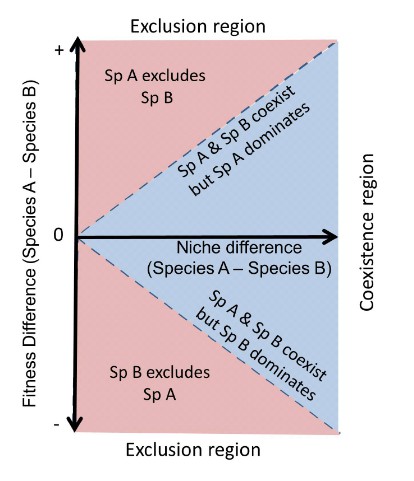Plant competition is a critical ecological process in agricultural and natural ecosystems and plays a major decisive role in changes in any botanical characteristic component of vegetation. Nutrients, water, and light are the three majors resources that limit plant growth and are considered resources for which individual plants compete. Due to the overlap of living space and living resources, the two plants coexist and compete. The basic elements of plant competitiveness include growth ability, survival ability, and reproductive ability. The competitive ability of plants is determined by a certain component or a combination of these three aspects. Plants with strong competitive ability may have relatively large individual plants, relatively long-life histories, or relatively high reproductive capabilities. Therefore, when evaluating the relative competitive ability of plants, all three aspects should be measured, or at least reasonable explanations should be given for the unmeasured aspects.
 Fig. 1. A theoretical coexistence scheme and competitive exclusion between two species. (Valladares et al., 2015)
Fig. 1. A theoretical coexistence scheme and competitive exclusion between two species. (Valladares et al., 2015)
We have a comprehensive plant competition model to simulate plant competition in a defined environment and to study the effects of various factors on plant development and survival. Lifeasible provides comprehensive plant competitiveness assessment services to determine plant competitiveness, using different coefficients to explain and summarize the intensity, effects, and consequences of plant competition. Different coefficients have different functions and conditions of application. We will select the most suitable coefficient for your purpose.
Our experts use competition coefficients to compare and characterize plant competition from different perspectives.
Competitive intensity integrates the physiological and morphological responses of individual plants in the presence of neighboring plants. It describes the process of competition between individual plants in a population or community. We provide relative competitive intensity (RCI), relative neighbor effect (RNE), and natural logarithm of response ratio (lnRR) methods to measure plant competitive intensity.
Competitive importance emphasizes competition in the future productivity or species composition dynamics of a plant community relative to other ecological processes (e.g., effects of predation, herbivores, pests, etc.).
We provide a series of coefficients to analyze the effects of competition on the density and frequency of plant populations, as well as to measure the effects of competition on plant growth, reproduction, and survival. These coefficients are calculated based on the yield per unit area of a species and reflect the collective behavior of a species.
We use a variety of measurement coefficients to analyze the consequences of competition between two species and the consequences of competitive succession in the community over time. These coefficients can provide valuable information for interpreting the consequences of plant competition.
Lifeasible is committed to designing experiments to assess the competitiveness of plant survival through a range of coefficients to measure plant competitiveness. If you are interested in our services, please contact us for more information.
References
Lifeasible has established a one-stop service platform for plants. In addition to obtaining customized solutions for plant genetic engineering, customers can also conduct follow-up analysis and research on plants through our analysis platform. The analytical services we provide include but are not limited to the following:
STU-CRISPR System Improves Plant Genome Editing Efficiency
April 19, 2024
Application of Exosomes in Facial Beauty
April 12, 2024